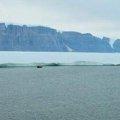The ice island that broke off from Greenland's Petermann glacier is more than four times the size of the New York City's Manhattan Island. Jim Scianna of the U.S. National Ice Center, tells VOA breakage like this is fairly routine in the Arctic.
"There's about 10-40,000 of them that occur during the year in the Arctic region. What's unusual about this one is the size," he said. And the size of the massive iceberg has some people worried, like Greenpeace activist Melanie Duchin. "I think this is more evidence to add to the growing body of knowledge that shows that climate change is happening," he said. Scientists say they cannot confirm whether the rip in the ice was caused by global warming because of a lack of information. They only started keeping records on the sea water around the glacier in 2003.
And ocean science professor Andreas Muenchow says years of data on the glacier itself show that after this month's event, the mass of ice is still, on average, discharging about the same amount of water it usually does - some 600 million cubic meters a year, or about 220,000 Olympic-sized swimming pools. "Even a big piece like this over 50 years is not that significant. It's just the normal rate," he said. Muenchow warns people not to jump to conclusions. "An event like this, this specific event, all flags go immediately up, 'Oh, let's explain this by global warming.' I cannot support that," he said. Nevertheless, Congressman Ed Markey, the Chair of the House committee on global warming, says the overall evidence is disturbing. "Scientists have warned us that climate change will result in increased melting of glaciers and polar ice, more frequent and intense heat waves and wildfires, and increased drought and flooding," he said. And people are experiencing extreme weather all over the world, from wildfires in the U.S. state of California, to droughts in Russia, to flooding in Pakistan.
But if this big break in the Greenland glacier IS caused by global warming, how would that affect us? "When they start to disintegrate and pieces break off, they start to move faster and they drain even more ice faster from the Greenland ice sheet in the sea, and that is what produces sea level rise," said Duchin. A sea level rise that could slowly erode shorelines across the globe. But those watching the Arctic changes at the ice center say there is no need to worry at the moment.
"This is about 250 square kilometers in area, the world's oceans make up about 361 million square kilometers, so you're talking still a very very very small percentage," said Scianna. Scientist will continue to monitor the ice island's path as it slides closer to the ocean. But they say only time will tell what damage, if any, will come from it.

